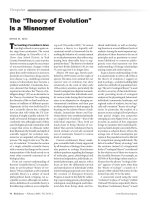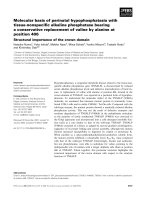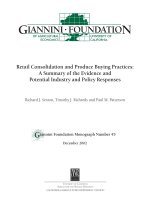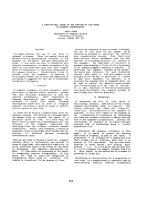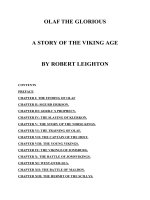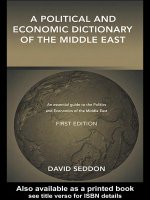A Theory of Creation: A Review of Vestiges of the Natural History pot
Bạn đang xem bản rút gọn của tài liệu. Xem và tải ngay bản đầy đủ của tài liệu tại đây (518.07 KB, 214 trang )
The Project Gutenberg EBook of A Theory of
Creation: A Review of 'Vestiges
of the Natural History of Creation', by
Francis Bowen
This eBook is for the use of anyone
anywhere at no cost and with
almost no restrictions whatsoever. You may
copy it, give it away or
re-use it under the terms of the Project
Gutenberg License included
with this eBook or online at
www.gutenberg.org
Title: A Theory of Creation: A Review of
'Vestiges of the Natural History of
Creation'
Author: Francis Bowen
Release Date: February 19, 2008 [EBook
#24648]
Language: English
*** START OF THIS PROJECT GUTENBERG EBOOK
THEORY OF CREATION ***
Produced by Bryan Ness, Greg Bergquist and
the Online
Distributed Proofreading Team at
(This
book was produced from scanned images of
public domain
material from the Google Print project.)
A THEORY OF CREATION.
A
REVIEW
OF
"VESTIGES OF THE
NATURAL HISTORY OF
CREATION."
FROM THE NORTH AMERICAN REVIEW
FOR APRIL, 1845.
BOSTON:
OTIS, BROADERS, AND COMPANY,
120 WASHINGTON STREET.
1845.
CAMBRIDGE:
METCALF AND COMPANY,
PRINTERS TO THE UNIVERSITY.
A
THEORY OF
CREATION.
Vestiges of the Natural History of
Creation. New York: Wiley &
Putnam. 1845. 12mo. pp. 291.
This is one of the most striking and
ingenious scientific romances that we
have ever read. The writer of it is a bold
man; he has undertaken to give a
hypothetical history of creation, beginning,
as the title-pages say, at the earliest
period, and coming down to the present
day. It is not quite so authentic as that of
Moses, nor is it written with such an air of
simplicity and confidence as the narrative
of the Jewish historian; but it is much
longer, and goes into a far greater variety
of interesting particulars. It contradicts the
Jewish cosmogony in a few particulars,
and is at variance with probability and the
ordinary laws of human reasoning in many
others. But the rather liberal rules of
interpretation, which it is now the fashion
to apply to the first chapter of Genesis,
will relieve the reader from any scruples
on the former account; and as to the latter,
in these days of scientific quackery, it
would be quite too harsh to make any
great complaint about such peccadilloes.
The writer has taken up almost every
questionable fact and startling hypothesis,
that have been promulgated by proficients
or pretenders in science during the present
century, except animal magnetism; and for
this omission we have reason to be
thankful. The nebular hypothesis,
Laplace's or Compte's theory of planets
shelled off from the sun, spontaneous
generation,—some of these vagaries, we
admit, are of much older date than the year
1800,—the Macleay system, dogs playing
dominoes, negroes born of white parents,
materialism, phrenology,—he adopts them
all, and makes them play an important part
in his own magnificent theory, to the
exclusion, in a great degree, of the well-
accredited facts and established doctrines
of science.
We speak lightly of the author's plan, as
one can hardly fail to do of a scheme so
magnificent, and going apparently so far
beyond the ordinary sources of
information and the range of the human
intellect. But the execution of the work is
of so high an order, as fairly to challenge
attention and respect. The writer, who has
not chosen to give his name to the world,
is evidently a man of great ingenuity and
correct taste, a master of style, a
plausible, though not a profound, reasoner,
and having quite a general, but superficial,
acquaintance with the sciences. His
materials are arranged with admirable
method, the illustrations are copious and
interesting, the transitions are skilfully
managed, and the several portions of the
theory are so well fitted to each other, and
form such a round and perfect whole, that
it seems a pity to subject it to severe
analysis and searching criticism. It is a
very pleasant hypothesis, set forth in a
most agreeable manner; and though it
contains many objectionable features,
these are cautiously veiled and kept in the
background, and the reader is seduced into
accepting most of the conclusions, before
he is aware of their true character and
tendency.
Before a just opinion can be formed of the
correctness of the writer's views, it is
necessary to take to pieces this skilful
fabric, and to bring the parts together in a
different connection and with greater
succinctness, following out each doctrine
to its inevitable, but most remote,
conclusions, so as to obtain a just idea of
the position in which we should be placed
by the acceptance of the theory as a
whole. For obvious reasons, the author
has not chosen to give a general summary
of his views, or to mention explicitly all
the inferences that may be drawn from
them. He merely puts the reader upon the
track, indicating its general direction, and
leaving it for him to find out what objects
will be encountered by the way, and
where the journey will end. We propose
to finish the work that is thus left
incomplete, and to set forth the doctrine in
its plainest terms. We would reduce the
theory at once to its narrowest compass
and simplest expression; but at the same
time, would incorporate into it every
doctrine which properly belongs to it, and
follow out each hypothesis to its remote,
though necessary, inferences and
conclusions. To this end, it is requisite to
separate, as far as possible, the doctrines
themselves from the evidence adduced in
support of them; and to consider the
former as a whole, before proceeding, to
discuss the cogency of the latter. The
following may be taken as the most
concise abstract that we can form of the
history of the creation, according to this
author.
In the beginning—we use this word in a
kind of preter-perfect sense—in the very
beginning of things, immense portions of
infinite space were filled with finely
diffused nebulous matter, heated to an
intensity that is altogether inconceivable.
The particles of this "fire mist," as it is
appropriately called, were the true
primordia rerum,—the elements of the
universe,—the principles of all the forms
of inorganic matter and all organic things.
At the outset, the Creator endowed these
particles with certain qualities and
capacities, and then stood aside from his
work, as there was nothing farther for him
to do. The subsequent progress of creation
is only the successive development, upon
mechanical and necessary principles, and
as fast as proper occasions were offered,
of these qualities thus made inherent in the
primitive constitution of matter. The atoms
thus marvellously endowed have gone on,
without any further aid from Almighty
power, to form suns, and astral systems,
and planets with their satellites, and
worlds tenanted by successive generations
and races of vegetable and animal things.
And this work of creation, or rather of
development, is still in progress all
around us, and in all its various stages,
though in the portion most directly
exposed to the observation of man it is far
advanced towards perfection. Upon this
earth, the unaided action of these atoms is
still evolving all the phenomena of
generation, progress, and decay, of
vegetable and animal life, of instinct and
of mind. In the abyss of space, it is also
forming new suns, and solar systems, and
worlds that are to pass through the same
stages and wonderful transformations to
which our own planet has already been
subjected. All that has occurred with
respect to this earth, and the system of
which it forms a part, is but a type of what
is constantly going on in the countless
other systems of stars that people the
firmament.
The first stage in the history of these fiery
particles is the formation among them, in
some unaccountable way, of nuclei, or
centres of aggregation, like the bright
points that are now visible in some of the
nebulæ of the heavens. As soon as these
centres are formed, gravity, one of the
original principles of matter, begins to act,
and the atoms in all the neighbouring parts
of space are attracted towards the nucleus
and heaped upon it. In this manner, a
central sun of vast dimensions is formed,
which soon assumes a motion of rotation
upon its axis from the general law which
gives a circular movement to all fluids
that are drawn towards a common centre.
The centrifugal force thus generated tends
to throw off matter from the equatorial
regions of the great orb, but is restrained
by the attraction of gravitation, which
would prevent any separation of the parts,
if the sun itself did not now begin to cool
down, and consequently to shrink in size.
Under this cooling process, a crust is
formed upon the surface, too rigid to yield
to the force of gravity, and the parts
within, continuing to shrink, separate from
this envelope; so that there is now a
central orb, revolving more rapidly from
its greater density and smaller diameter,
and surrounded by an exterior shell, or
band, like Saturn's ring, rotating at its
original speed. As we cannot suppose that
the ring would usually be of uniform
thickness and strength, it eventually breaks
up into fragments, the larger of which
attracts the smaller into itself, and the
whole is formed by its revolving motion
into an oblate spheroid circling round the
contracted sun in the centre. In this
manner, the planet Uranus was shelled off
from our sun, which originally filled the
whole of the vast sphere, of which the
distance from Uranus to the centre of the
present sun is but the radius. The planet
itself, by the same process of cooling,
shrinking, and thus forming exterior rings,
threw off successively all its six satellites;
and the sun, also, continuing to contract
from the loss of heat, formed another ring,
and thus constituted the planet Saturn. In
this way were formed successively all the
planets and satellites of the present solar
system. The original diameter of our earth
was equal, of course, to the present
diameter of the moon's orbit. In the case of
Saturn, the two rings formed around it
happened to be of unusual homogeneity
and equal thickness, so that they were not
broken up, but have preserved their
primitive shape. A ring was formed from
the sun in the space between the present
orbits of Mars and Jupiter; but when it
was broken up, the fragments did not
congregate into one, but spherified
separately, so as to form the four smaller
planets which now revolve in that
opening.
"We have no means of judging of
the seniority of systems; but it is
reasonable to suppose, that, among
the many, some are older than ours.
There is, indeed, one piece of
evidence for the probability of the
comparative youth of our system,
altogether apart from human
traditions and the geognostic
appearances of the surface of our
planet. This consists in a thin
nebulous matter, which is diffused
around the sun to nearly the orbit of
Mercury, of a very oblately
spheroidal shape. This matter,
which sometimes appears to our
naked eyes, at sunset, in the form of
a cone projecting upwards in the
line of the sun's path, and which
bears the name of Zodiacal Light,
has been thought a residuum or last
remnant of the concentrating matter
of our system, and thus may be
supposed to indicate the
comparative recentness of the
principal events of our cosmogony.
Supposing the surmise and inference
to be correct, and they may be held
as so far supported by more familiar
evidence, we might with the more
confidence speak of our system as
not amongst the elder born of
Heaven, but one whose various
phenomena, physical and moral, as
yet lay undeveloped, while myriads
of others were fully fashioned and
in complete arrangement. Thus, in
the sublime chronology to which we
are directing our inquiries, we first
find ourselves called upon to
consider the globe which we inhabit
as a child of the sun, elder than
Venus and her younger brother
Mercury, but posterior in date of
birth to Mars, Jupiter, Saturn, and
Uranus; next, to regard our whole
system as probably of recent
formation in comparison with many
of the stars of our firmament. We
must, however, be on our guard
against supposing the earth as a
recent globe in our ordinary
conceptions of time. From evidence
afterwards to be adduced, it will be
seen that it cannot be presumed to
be less than many hundreds of
centuries old."—pp. 22, 23.
Having thus explained the genesis of the
solar system, we come down to the history
of our own earth, since it shelled off the
ring which formed our moon. Continuing
to cool down and shrink, a thin but rigid
crust of primary rocks, still bearing marks
of the intense heat to which they have been
subjected, was formed upon its surface;
and then the vapors, with which the
atmosphere had been charged, were
condensed, and formed seas, which
covered the whole, or the greater part, of
the earth's rind. The continual agitation of
these waters, and their high temperature,
as they were still nearly at the boiling
point, disintegrated and wore down many
of these rocks, and, in the lapse of ages,
deposited their remains, in thick layers of
sand and mud, at the bottom of the seas.
Baked by the heat from beneath, and
pressed by the weight of superincumbent
waters, these layers slowly hardened into
stratified rocks. Forms of vegetable and
